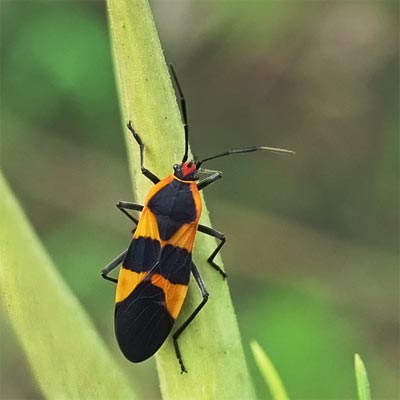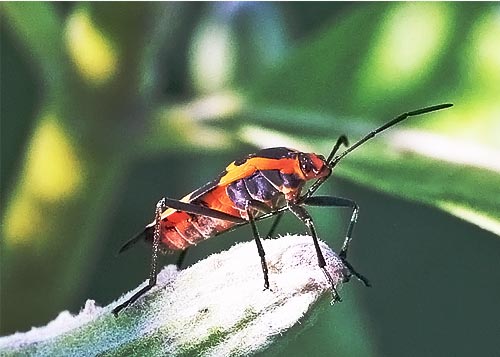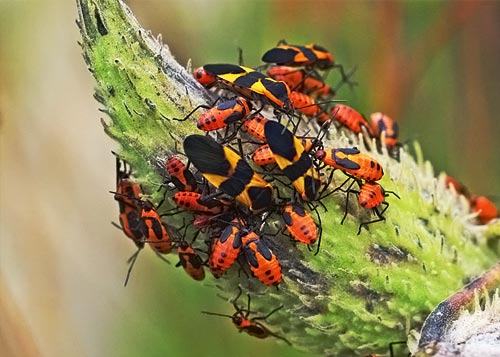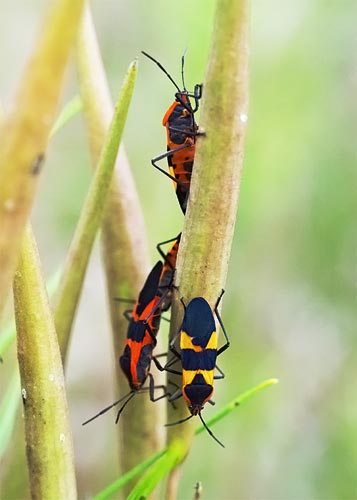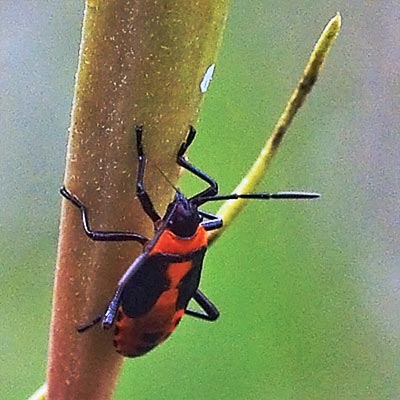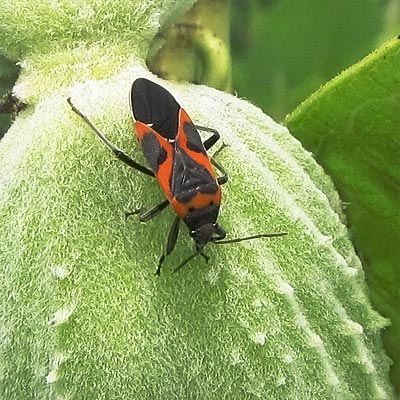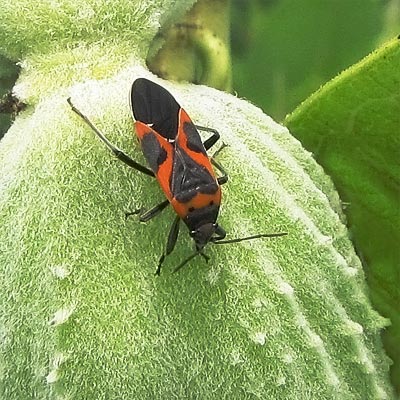Howdy, BugFans,
Milkweed bugs (MBs) rated about four lines in a BOTW about Milkweed Critters a little more than a year ago, but these beautiful insects are having a blockbuster year and deserve to be disarticulated from that group and considered in their own right(s).
Milkweed Bugs
Milkweed bugs come in two flavors—Large (¾”) (LMB) and Small (½”) (SMB). MBs are True Bugs, in the Order Hemiptera (“half-wings”). That means you can call them “bugs” without being frowned upon by eminent entomologists. They don’t actually have half-wings, but their front set of wings is half leathery and half membranous (the second set, the flying wings, are 100% membranous). They are in the Seed Bug bunch (family Lygaedidae), which get their name because they suck juice from seeds. MBs of one kind or another are found on milkweeds across the U.S. and southern Canada, and they are most common in the Southeast.
It’s been speculated that the Hemipteran ancestor had chewing mouthparts, but Hemipterans have strayed rather far since then. MBs’ consist of two, side-by-side tubes; they use one tube to pump digestive enzymes into the tough milkweed seeds and the other to siphon up the softened plant material. Between feedings, the tubes are held out of the way against the underside of the body. If you look closely under the chin of the MB profiled on the pod, you can see the mouthparts tucked between its front legs.
Unlike most insects, MBs are gregarious, and milkweed pods may be covered with adults and nymphs (the nymphs start out solid red-orange and add some black markings each time they molt. Older adults are darker red). One reference theorized that everybody benefits from communal feeding behavior. More feeding tubes = more saliva = more softening = more food. During large outbreaks, milkweed seed production suffers; the inner seeds are safe, but the whole pod seems dysfunctional. Most sources say that MBs have no economic importance, since they don’t attack crops, carry disease, or otherwise cross paths with humans, but people who raise milkweeds or collect seed are not fans.
Both MBs are reported to feed on some nectar, and when food is scarce, MBs may eat other milkweed parts and live or dead invertebrates. SMBs’ tastes may wander to non-milkweed species.
MBs have several ways to protect themselves from predators. If you get too close to a group, the individuals will scatter. When alarmed, MBs drop off the plant into the thicket of grasses at its base. Once on the ground, they lie still for a while before resuming their eating. Predators prefer to kill their food and generally won’t bother an animal that is “dead.”
These behavioral methods are really unnecessary, because MBs, like Monarchs, taste nasty due to the bitter sap in their favorite food. This begs the question of taste buds among its predators—birds notably lack them, and the BugLady doubts the palettes of praying mantises and garden spiders. MBs are poisonous due to milkweed’s cardiac glycosides (insects that make use of milkweed carbs must either produce chemicals to detoxify them or structures to sequester the toxins). MBs are sequester-ers. At the very least, eating a bunch of MBs will make the predator vomit and develop a strong avoidance reaction to the next MB it lays eyes on (one on-line source warned readers not to let their dogs eat MBs). MBs wear Mother Nature’s warning colors of orange and black, and their habit of feeding in large groups magnifies those colors for near-sighted predators. The bright reddish-orange and black color patterns of the MBs are called aposematic (they are aposematically colored), which, according to Merriam Webster, means “being conspicuous and serving to warn–as in coloration.” There’s some speculation that the non-poisonous box elder bugs are milkweed bug mimics.
With one major exception, SMBs (Lygaeus kalmii) and LMBS (Oncopeltus fasciatus) have very similar life stories. Egg to nymph to adult in one to two months, depending on the air temperature. Mating (about 30 minutes in duration in warm weather, with snuggles as long as 10 hours occurring in cool weather) and egg-laying within a week of reaching adulthood (up to 2000 eggs total, half male, half female. The eggs also change color, from pale yellow to almost-red as hatching nears). One or two months of adulthood, and they overwinter as adults. The big difference between SMBs and LMBs is that SMBs can overwinter here in God’s Country and LMBs can’t. SMBs are “permanent residents” and LMBs are migratory, following the milkweed crop north in summer and retreating south in fall. According to Stokes in Observing Insect Lives, about a quarter of LMB adults are migratory–crowded milkweed pods, decreasing northern day lengths, and less reproductive activity send them south, and those that linger, freeze. SMBs crank out the antifreeze and survive northern winters; on warm winter days down south, LMBs may stretch their legs.
Most of what the BugLady has been seeing this year have been LMBs. LMBs (¾”) have a broad, black band across their back, and SMBs (½”) have a red “X” on a black background.
LMBs are available from scientific supply catalogs, along with complete rearing instructions (they’ll eat sunflower seeds and watermelon in captivity) and they are reported to be “easy to dissect.”
The BugLady
